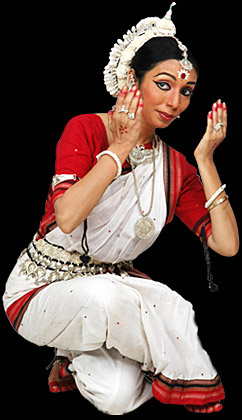 Abhinaya is pure demonstration of an emotion contained in a song or lyric. This is one of the most important items of Odissi in which the performer interprets the song in movements which becomes a poem-in-action. The tradition of songs as known in today`s Orissa perhaps began in the 12th century with the well known Astapadies of Jayadeva. The Sanskrit songs of Geeta Govinda are in direct ancestral line of songs and musical poetry in Orissa. The talas and ragas are the same, so are the theme and the tendency to being ornate through assonances and alliterations. In medieval Oriya Literature the composers fixed the tala and raga of each song as in those of Geeta Govinda. This has greatly helped the maintenance of the purity of the style and continuance of the tradition.
The Oriya songs are mostly medieval compositions of a large number of Vaishnavite poets and the theme obviously pertain to the sport of Radha and Lord Krishna. Among the composers, three dominate the field. They are Kavisurya Baldeva Ratha, Gopal Krishna Patnaik and Banamali Das. Of this trinity, Kavisurya is the most musical, Gopal Krishna the most poetic and Banamali the most devotional. The Oriya songs of these composers are nothing but the vernacular counterparts of the love-lyrics of Jayadeva in Sanskrit.
Abhinaya is pure demonstration of an emotion contained in a song or lyric. This is one of the most important items of Odissi in which the performer interprets the song in movements which becomes a poem-in-action. The tradition of songs as known in today`s Orissa perhaps began in the 12th century with the well known Astapadies of Jayadeva. The Sanskrit songs of Geeta Govinda are in direct ancestral line of songs and musical poetry in Orissa. The talas and ragas are the same, so are the theme and the tendency to being ornate through assonances and alliterations. In medieval Oriya Literature the composers fixed the tala and raga of each song as in those of Geeta Govinda. This has greatly helped the maintenance of the purity of the style and continuance of the tradition.
The Oriya songs are mostly medieval compositions of a large number of Vaishnavite poets and the theme obviously pertain to the sport of Radha and Lord Krishna. Among the composers, three dominate the field. They are Kavisurya Baldeva Ratha, Gopal Krishna Patnaik and Banamali Das. Of this trinity, Kavisurya is the most musical, Gopal Krishna the most poetic and Banamali the most devotional. The Oriya songs of these composers are nothing but the vernacular counterparts of the love-lyrics of Jayadeva in Sanskrit.
These together have been the entire emotional as well as the musical repertoire for the art of dance in Orissa. The songs in this item are sung by the vocalist. Besides the Oriya songs, excerpts from the Geeta Govinda are commonly used. Mostly, these romantic compositions are set in a slow tempo and the dancer gets full scope to depict the emotion by gestures, glances and softer movements to bring home to the audiences the full meaning of the compositions. The dancer while portraying the bhava brings out the myriad nuances of the Nayaka-Nayika concept of Hindus erotic psychology. The songs used in this item deal with devotion or Bhakti Rasa. Dasavatara of Geet Govind is the most popular item in this regard.
Hence it can be concluded saying that Odissi dance receives completion only along with its music, melody and the abhinaya techniques of the performers. It is with the abhinaya of the performers that Odissi dance becomes beautiful and meaningful.




